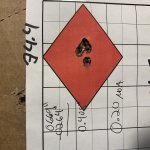Here's an update on my Savage 110 Elite Precision .308 . As discussed ( at great length ) , performance with the 175 SMK was initially quite disappointing . Fliers , fliers and more fliers . I tried every load combination that even reasonably made sense . Scope change , powder change , etc , etc . No joy .
I had been testing on a bench off a sandbag ( that worked great with my long range .223 ) . It just seemed so strange that a rifle at this price point shooting good ammo would perform so inconsistently . I had a similar initial experience when tuning a new R700 Milspec .308 . Then , it dawned on me . What's the same with these two rifle systems ? The sandbag setup and the actual range / bench . So , just to disprove a theory , I decided to go to a different range facility and try shooting prone off a bipod . Now , due to a serious , permanent back injury , my prone skills are poor as shooting in pain is not that enjoyable . However , the 175 SMK results were quite different . I really intended to just get a 100M zero and call it a day , but , decided to shoot 3 , 4 shot groups to see what happened . Group 1 , .364MOA , group 2 , .209MOA and group 3 , .173MOA . Now , three , 4 shot groups at 100M prove very little , but , that's a marked improvement . So , was it the sandbag ? Was it movement in the bench ? Was it blind luck ? Who the F knows ? I will try this again at longer range in the next couple of days to see what happens . For the record , 175 SMK , 43.0 Varget , Lapua SRP brass ( fully prepped ) , BR4 primers , .020 off , .001 runout . The Elite Precision saga continues










































































